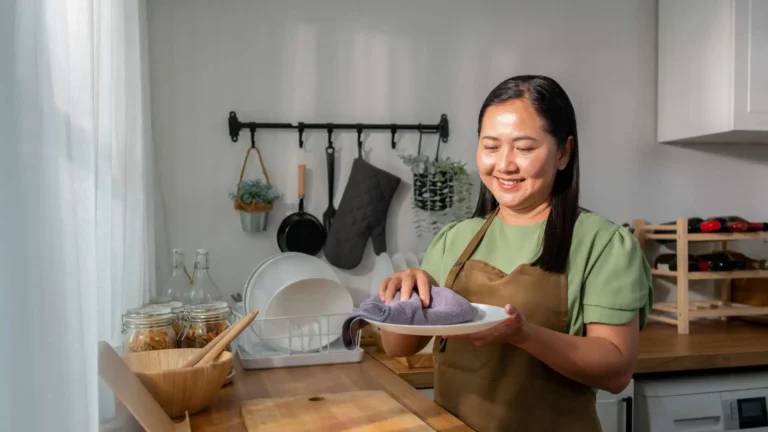Table of Contents
Cooking at home not only allows you to eat healthier but can also save you a significant amount of money compared to constantly ordering takeout or dining out. However, the key to maximizing savings while cooking at home lies in the tools you use. The right kitchen gear can streamline your cooking process, reduce food waste, and help you create meals at a fraction of the cost of pre-packaged foods or restaurant meals.
In this guide, we’ll explore kitchen gear that pays for itself in 90 days—tools that, with just a little investment upfront, will save you money in the long run. By focusing on efficiency, reducing food waste, and eliminating the need for store-bought or takeout meals, these kitchen gadgets can quickly repay their cost.
The 90-Day ROI Concept
When we say that kitchen gear can “pay for itself,” we’re talking about how the cost of a tool can be offset by the money you save over time. Whether it’s through reducing grocery bills, cutting out expensive takeout, or making meal prep more efficient, the right kitchen tools can offer significant returns on your investment.
For example, a pressure cooker might cost around $100, but if it helps you cook meals that are both cheaper and faster, it can pay for itself in less than three months. You’ll stop relying on costly pre-cooked meals or waiting for hours to cook tougher cuts of meat. The savings from eating home-cooked meals regularly quickly make that initial purchase worth it.
Must-Have Kitchen Gear That Pays for Itself
1. High-Quality Knife Set
A quality knife set is one of the most important tools in your kitchen, and it’s something that pays for itself over time. It’s not just about cutting with precision but also about saving time and preventing food waste.
- Benefits: Sharp, well-made knives make prep work faster and safer. A high-quality chef’s knife can handle almost any task, from slicing vegetables to deboning chicken. Plus, using the right knife prevents you from having to rely on pre-cut produce, which costs significantly more.
- ROI: A good knife set can last for years if maintained properly. Instead of buying pre-cut vegetables or packaged meat that costs more, you’ll be able to prep everything yourself at home. For example, buying whole carrots and cutting them yourself is far cheaper than buying pre-cut bags.
- Example: If a set costs $150, it might pay for itself by saving you around $50–$100 per month on produce and food prep. In just three months, the knife set will have essentially paid for itself.
2. Instant Pot/Pressure Cooker
The Instant Pot has revolutionized the way we cook, combining multiple cooking functions into one appliance. From pressure cooking to slow cooking, sautéing to rice cooking, it can do it all.
- Benefits: The Instant Pot saves time by speeding up cooking processes, making it easier to cook meals like stews, soups, and braised dishes in a fraction of the time it would take using traditional methods. It also uses less energy, saving you on utility bills.
- ROI: By cooking cheaper cuts of meat and making meals that would normally take hours in a slow cooker, you can reduce your reliance on takeout or pre-packaged meals. On average, you could save $3–$5 per meal by preparing home-cooked meals instead of ordering delivery.
- Example: If you prepare just three meals a week using the Instant Pot, you can save $20–$30 per week on dining out or takeout. This could easily cover the cost of the Instant Pot within 90 days, especially when considering how much you’d save on utility bills and time.
3. Blender/Food Processor
Whether you’re making smoothies, soups, or sauces, a high-quality blender or food processor can transform your kitchen experience. These tools can help you make healthier meals from scratch, saving money on pre-made items.
- Benefits: A blender or food processor opens up a world of homemade meals. From smoothies to nut butters, from soup to salad dressings, you’ll no longer need to buy expensive pre-made versions.
- ROI: Pre-packaged smoothies, juices, and dressings can cost anywhere from $3–$8 per serving. By using a blender or processor, you can make these for a fraction of the cost. For example, making your own almond butter or hummus from bulk ingredients could save you $4–$5 per jar compared to store-bought.
- Example: A blender may cost around $100, but by replacing store-bought smoothies and pre-made dips, you could save $50 or more per month. In 90 days, this purchase could easily pay for itself through savings on pre-packaged food.
4. Cast Iron Skillet
A cast-iron skillet is the kitchen tool that keeps on giving. Known for its durability and heat retention, it can be used for everything from searing steak to baking cornbread.
- Benefits: A cast-iron skillet allows you to cook meals evenly and retain heat, which can reduce cooking time. It also lasts a lifetime with proper care and can replace multiple pans, saving you money on kitchen gear over time.
- ROI: A single high-quality cast iron skillet can replace multiple other pans, eliminating the need for single-use cooking tools. By cooking more efficiently and reducing the need for additional cooking equipment, you save money in the long run.
- Example: A good cast-iron skillet costs around $30–$50, and it can last for decades. The cost savings come from using it for multiple cooking techniques and reducing the need for other pans. Over time, this small investment provides substantial savings on cookware.
5. Coffee Maker or Espresso Machine
For coffee lovers, a coffee maker or espresso machine offers significant savings over daily visits to coffee shops.
- Benefits: Brewing coffee at home costs only a fraction of what you would pay at a café. With a machine, you can enjoy high-quality coffee at home for a fraction of the price, often with the added benefit of better taste.
- ROI: A high-quality coffee machine may cost around $100–$200, but consider how much you spend on coffee from cafés. If you buy coffee for $3–$5 per day, you could be spending $900–$1,500 annually. A coffee machine could pay for itself in just three months, depending on how often you brew at home.
- Example: A $150 coffee maker could save you $50 per month if you normally spend $2–$5 per day on coffee. That adds up to $600 in savings over the year—more than enough to cover the initial investment. Read related blog: Food Prep Hacks: Save $100 per Month on Groceries
Additional Kitchen Tools to Maximize Savings
Food Storage Containers
Proper food storage is essential for minimizing food waste and maximizing your grocery spending. Containers that keep food fresh can help you store leftovers and bulk ingredients more effectively.
- Benefits: By storing food properly, you reduce spoilage, cut down on wasted groceries, and maximize your meal planning. This will help you buy in bulk and store extras for future meals.
- ROI: Investing in quality containers can help you save on grocery bills by reducing waste. You’ll find that meal prepping and storing food efficiently can save you 10–20% on grocery bills.
Rice Cooker
For many, a rice cooker is a must-have tool that simplifies cooking. It ensures perfectly cooked rice every time and is versatile enough to cook grains like quinoa and oatmeal.
- Benefits: It saves time and effort compared to stovetop cooking, and it consistently produces better rice.
- ROI: By cooking rice and grains at home rather than buying pre-made meals or takeaway rice dishes, you’ll save money. A rice cooker typically costs $20–$50, and you can save $10–$20 each month by replacing packaged rice and grains.
Cost-Benefit Analysis of Investing in Kitchen Gear
When evaluating kitchen gear, it’s important to balance the initial cost with the long-term savings. While high-quality tools may seem expensive at first, their durability and efficiency mean you’ll save money over time. For example, investing in a good knife set or Instant Pot may cost more upfront but will save you hours of cooking time and hundreds of dollars in takeout over the next few months.
How to Choose Gear That Works for You
To maximize your investment, prioritize versatility and durability. Choose tools that you will use frequently and that will last for years, such as a high-quality blender, a cast-iron skillet, or a coffee maker. These items will give you the best return on investment by saving you time, money, and effort in the kitchen.
Conclusion
Investing in the right kitchen equipment can significantly elevate your cooking experience and deliver meaningful savings over time. By choosing well-made essentials—such as a cast-iron skillet, an Instant Pot, or a high-quality blender—you can reduce food waste, speed up meal preparation, and avoid high-cost takeouts. You’ll not only cook better, but spend smarter.
With Beem, managing your kitchen gear purchases becomes easier and more strategic. Its features include instant cash access up to $1,000, a smart wallet with FDIC-insured protection, and the free Beem Card to build credit with every purchase. Beem Whether you’re buying a premium piece of gear or handling unexpected kitchen expenses, Beem gives you the flexibility and financial clarity you need.
Download the Beem app today to take control of your spending, make intentional kitchen investments, and start cooking smarter—without straining your budget.
FAQs
Which kitchen tool offers the highest ROI for everyday cooking?
The Instant Pot offers the highest ROI for everyday cooking. It combines multiple appliances (pressure cooker, rice cooker, slow cooker, and steamer) into one device, saving you time, energy, and money. It’s versatile enough to make everything from soups to casseroles and speeds up cooking, making it a top investment for home cooks.
How do I make sure my kitchen gear actually pays for itself?
To ensure your kitchen gear pays for itself, use it regularly and maximize its functionality. For example, a blender can make smoothies, soups, and sauces, while a rice cooker can be used for a variety of grains. By replacing store-bought products and reducing takeout, the savings from cooking at home will quickly offset the initial investment in the gear.
Can I save money by upgrading my kitchen gear gradually, or should I invest in everything at once?
It’s better to upgrade your kitchen gear gradually. Start with essential tools that will provide the most immediate savings, like a good knife set or Instant Pot. Once you see the savings in food costs and meal prep efficiency, you can invest in additional tools. This way, you’re spreading out the expense while ensuring that each purchase brings value.
How do I choose between different brands of kitchen gear?
When choosing between different brands, focus on durability, reviews, and versatility. For example, Cast Iron skillets from reputable brands like Lodge offer excellent heat retention and long-lasting performance. Compare prices, warranty options, and customer feedback to select gear that meets your needs without overspending on premium brands unless necessary.
What’s the best way to balance kitchen gear investment with a tight budget?
To balance kitchen gear investment with a tight budget, prioritize essential items that offer the most versatility and long-term savings, like a good knife set or pressure cooker. Look for high-quality, durable tools that will last for years rather than cheap, single-use gadgets. Gradually build your collection as you find areas where the gear enhances your cooking and saves money.















































